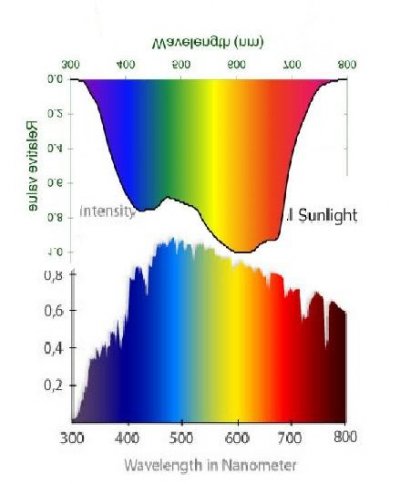It may help here to define these different spectral charts.
Absorption spectrum- is simply related to light that is absorbed by whatever object is being considered, tissue, chloroplast, chlorophyll etc.
Action spectrum- is a relation to the "Quanta" of light intercepted by said object vs the amount of O2 or CO2 evolved.
Quantum Efficiency (Yield) - (McCree) is a relation of Efficiency by Comparing then number of "Absorbed" Quanta vs the "Action" of CO2 evolution.
There has been many tests regarding the accuracy of action spectrum (typically specific to Chlorophyll, carotenoids or xanthophylls) and process were proved effective even in the 60's. There were also tests done on whole plants or tissues as well. However, accurate correction for the alteration of spectrum via solutions was not achieved until the late 1980's. Action spectrum then been verified to be accurate, though never intended to be a representation of "requirements" per se.
60's paper checking accuracy:
60's paper for action spectrum of whole tomato at different lights:
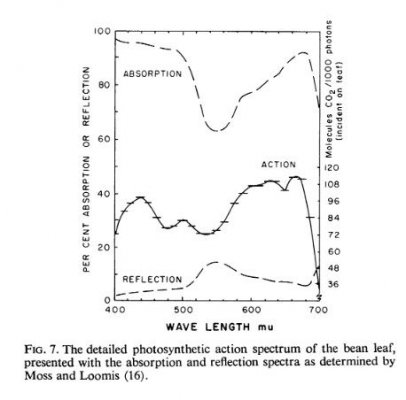
Modern Action spectrum and Corrected action spectrum (for solution and Chlorophyll A/B) along with an absorption vs quantum yield chart:
http://plantsinaction.science.uq.ed...-absorption-and-photosynthetic-action-spectra
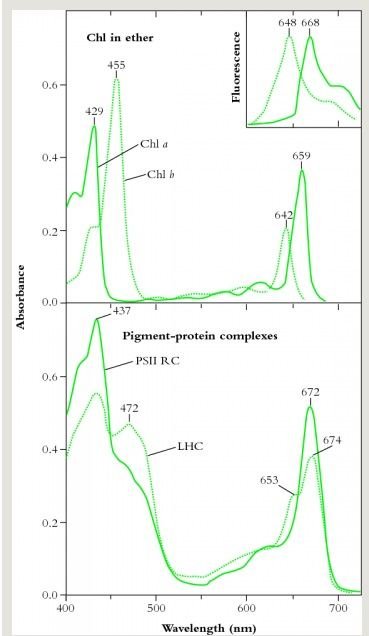
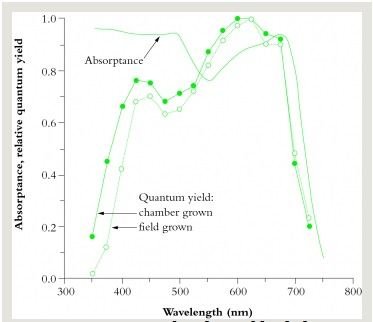
from that page, in regards to applying "efficiency" to quantum yield:
"Quantum yield is referenced to values obtained in red ligh(600-625 nm), which is most effective in driving photosynthesis, requiring about 10 quanta per CO2 assimilated (based on high-precision leaf gas exchange) compared with about 12 quanta at the blue peak (450 nm)."
Since it takes more quanta absorbed for CO2 action in the blue range; it is shown on the McCree curve as "less efficient" than red. Each of the corresponding wavelengths was plotted in terms of "efficiency".
One problem though with the McCree curve which has been investigated is that; it can only be derived under low light situations and "assumes" that the response in higher light is linear. Modern investigation into this has found this to not be the case; though of course not a major alteration, but probably the most accurate.
Here is a very good paper that is pretty recent on this:
http://www.bio21.bas.bg/ipp/gapbfiles/v-26/00_1-2_58-69.pdf
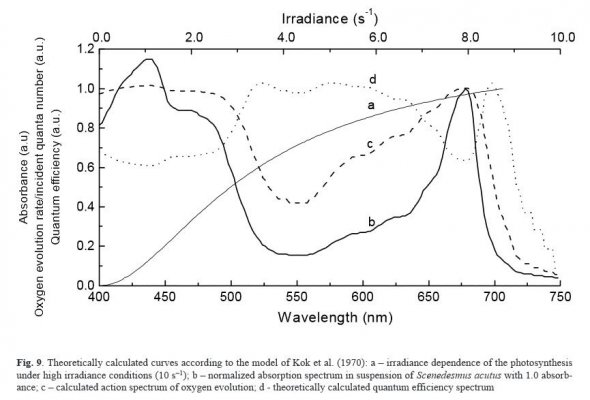
Also then, when considering PAR, it is of note that all frequencies between 400 and 700nm are treated with "equal value" despite there being different levels of efficiencies @ differing wavelengths. As well the sensors utilized for par readings are not necessarily the most accurate either. Not in anyway discounting PAR of course, just bringing forth some shortcomings.
LINK to sensor comparisons.
One final paper here that's pretty decent as well; compares the photosynthesis rates and lighting sources for a crop of wheat. It also compares the spectral efficiency of various lights.
http://biology.mcgill.ca/Phytotron/LightWkshp1994/1.5 Bugbee/Bugbee text.htm
TABLE 2. The spectral efficiency of six electric lamps and sunlight.
Lamp type Ratio
- Low Pressure Sodium (LPS) .99
- High Pressure Sodium (HPS) .95
- Incandescent (INC) .95
- Metal Halide (MH) .90
- Cool White Fluorescent (CWF) .89
- Red Light-Emitting Diode (LED) .89
- Solar on a clear day .88
"Spectral efficiency is defined as the ratio of the lamp spectral output multiplied by McCree's quantum efficiency weighting factors, divided by the number of photons between 400 and 700 nm."
"Not all species are sensitive to spectral quality, however. Low-pressure sodium lamps did not decrease the growth and yield of wheat compared to HPS and MH lamps (Table 3), a finding we recently confirmed. The plants under the low pressure sodium lamps of course did not look green, but the apparent difference in green color disappeared when the plants were removed and placed together in full spectrum light. Studies with wheat grown under red LED's also indicate that chlorophyll synthesis, photosynthesis, growth, and yield of wheat (Triticum aestivum) are insensitive to spectral quality."
.....
"Soybean leaves grown under HPS lamps are visually chlorotic and have reduced chlorophyll concentrations compared with plants grown under MH lamps. However, most plant leaves have excess chlorophyll, and small reductions do not necessarily decrease photosynthetic rates. Three recent studies in our laboratory confirm the reduction in chlorophyll under HPS lamps, but indicate that this reduction does not reduce growth or yield (Table 4). In fact, growth and yield were slightly better under HPS lamps. There was greater petiole elongation in plants grown under HPS lamps, but we lowered the plants as they grew taller to maintain a constant PPF at the top of the canopy. Lateral spread was prevented by enclosing the plants with a double layer of window screen around the perimeter of the stand. The reduced chlorophyll concentration may have increased PPF transmittance and allowed more PPF to penetrate to lower leaves in the canopy, thereby increasing canopy photosynthesis."
.....
"Differences in radiation quality from the six most common electric lamps have little effect on photosynthetic rate. Radiation quality primarily alters growth because of changes in branching or internode elongation, which change radiation absorption. Growth and yield in wheat appear to be insensitive to radiation quality. Growth and yield in soybeans can be slightly increased under high pressure sodium lamps compared to metal halide lamps, in spite of greatly reduced chlorophyll concentrations under HPS lamps. Daily integrated photosynthetic photon flux (mol m-2 d-1) most directly determines leaf anatomy and growth. Photosynthetic photon flux levels of 800 μmol m-2 s-1 are adequate to simulate field daily-integrated PPF levels for both short and long day plants, but plant canopies can benefit from much higher PPF levels."
One last thing here as it strikes me as humorous. Since the Quantum Yield is a relation of "efficiency"; then to get equivalent CO2 evolution for each given wavelength.......the required spectrum must be the inverse of the chart shown. So, what does that look like? Well here is the McCree curve shown in a post above, inverted onto a "sunlight" spectrum. Decent match I'd say :D.
